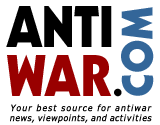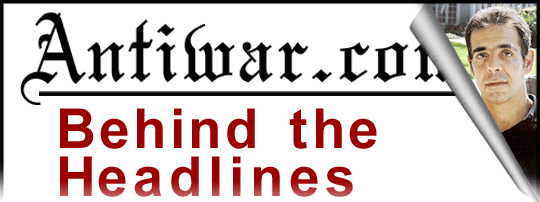The horrific murder of Alexander Litvinenko, ex-KGB officer and minor conspiracy theorist, has unleashed a wave of Russophobia that is sweeping over the Western media with Katrina-like force – washing away reason, logic, and the natural curiosity that makes for good investigative journalism. In their rush to convict Russian President Vladimir Putin as the evil mastermind behind this grisly death, Western journalists don’t seem to need all that many facts to condemn Putin as a murderous fiend. Litvinenko was a critic of Putin, he was subsequently poisoned in a horrible manner – and what more do we need to know? Apparently, nothing.
Yet the facts, insofar as we know them, are not bearing out this conclusion. To begin with, all of the known possible suspects – the people Litvinenko met with the day he fell ill – are vehemently anti-Putin, and avowed enemies of the Russian intelligence services. Mario Scaramella, an Italian professor who served on the Mitrokhin Commission and is head of something called the Environmental Crime Prevention Program, met with Litvinenko purportedly to warn him of an assassination threat received by e-mail. Litvinenko also met with three Russians at the Pine Bar at the Millennium Hotel – one of the Russians, an ex-KGB officer named Andrei Lugovoi, was a strong-arm type in his KGB days, a bodyguard to big-time Russian politicians like Yegor Gaider. Lugovoi fled Russia under a cloud when he was arrested (and mysteriously released) after helping one Nikolai Glushkov – an associate of billionaire oligarch Boris Berezovsky – escape from prison, where he was being held on charges of embezzlement (to the tune of $250 million) and massive fraud.
While Putin has been tried and convicted in the yellow pages of the British tabloids, and the pundits and editorial writers only need to know what Alex Goldfarb tells them, Scotland Yard does need to know more. Investigators are going through the evidence methodically, with the help of the radioactive trail left by the victim as he went about his business on Nov. 1, presumably blithely unaware that, somewhere along the way, he had ingested a deadly poison.
As the authorities trace Litvinenko’s movements on Nov. 1, reconstructing his various meetings and interviewing and examining those he came into contact with, the likelihood is that, as they work their way back, they will discover the murderer (or murderers). In this case, a timeline is an important tool, but the problem is that the details are in some doubt. The Times of London has this timeline, which puts Litvinenko’s "lunch" meeting with Mario Scaramella at 3 p.m., and a meeting with the three Russians as lasting from 4:30-6 p.m. However, this story in the Independent avers:
"The first [meeting], at 10 a.m., was at the Millennium Mayfair Hotel in central London with Sergei Lugovoy [sic], a former KGB bodyguard and businessman who runs a security company in Moscow. Mr. Lugovoy said he had been in London to watch a football match between Arsenal and CSKA Moscow. Also at the meeting were two other people unknown to Mr. Litvinenko – Dmitry Kovtun, the business partner of Mr. Lugovoy, and another friend and partner named as Vyacheslav Sokolenko. "
The Independent has the meeting with Scaramella at 3 p.m. The sequence matters, because, as the Times of London reports, symptoms of polonium-210 poisoning "including vomiting begin to appear an hour or so after the victim is irradiated." Whoever met with Litvinenko last is likely to be the prime suspect (or suspects), as it’s unlikely he’d conduct a meeting in the midst of a vomiting fit.
It also appears that the number of meetings the victim had that fateful day was initially underestimated. The radioactive trail has led police to focus on six locations, so far, which are now sealed off and undergoing tests: aside from the venue of the lunch (Itsu, a sushi restaurant) and the Pine Bar of the Millennium Hotel, we have
"Litvinenko’s house in North London and a section of the hospital where he was treated when he fell ill on Nov. 1. Two other sites – an office block in London’s west end and an address in the posh neighborhood of Mayfair – also showed traces of radiation, Scotland Yard said.
"All the locations except Litvinenko’s home are in west London, separated by about a mile. … The building near the Millennium Hotel contains a business intelligence company, Titon International Ltd , whose CEO was a former U.K. Special Services director, and Erinys UK Ltd., which has done security, logistics, and crisis management work in Iraq and other places.
"The other location reportedly houses an office of Boris Berezovsky, the self-exiled tycoon and Kremlin critic wanted in Russia on money-laundering charges. Businesses listed at the address include a fund adviser, an investment firm, an energy company, and offices of the newspaper publisher Metro International."
The official explanation for the visit to Berezovsky‘s office is simple: the Russian oligarch had sponsored and succored this out-of-work toenail-puller, and it was only natural for him to drop in to the office, use the copy machine, make a few phone calls, and shoot the bull with his fellow anti-Putinistas. However, the visit to Erinys/Titon International is a bit harder to explain away as a mundane event.
The dictionary defines Erinys as "an avenging deity; one of the Furies; sometimes, conscience personified," and doesn’t that send a bit of a chill down the spine? Alarm bells ought to be going off, at this point, as we learn that Erinys has its roots in the South African apartheid regime’s intelligence apparatus, and, in its present incarnation, has links to Ahmed "Hero in Error" Chalabi and the Iraqi National Congress.
Erinys secured a contract from the Coalition Provisional Authority worth $80 million to protect Iraq’s oil infrastructure, and you can see what a good job they’ve been doing. While this may not be a bargain for American taxpayers, it is a good deal for the INC, practically a guarantee of permanent employment for Chalabi’s gang. Erinys employs their top people as legal counsel and uses Chalabi’s militia for the strong-arm stuff: 14,000 strong. And you thought the U.S. subsidy to Chalabi & Co. had ended!
Titon International, headed by the same CEO, is variously identified as a "private investigator," and also an agency engaged in "confidential" "computer forensic investigation," whatever that is: their Web site describes them as
"An independent Business Intelligence Company providing a wide range of bespoke security and intelligence services to the commercial world both in the UK and Overseas. All Titon services are necessarily discreet and precisely tailored to the client’s requirement – client confidentiality is of paramount importance to us and is always guaranteed."
Titon’s graphic symbol, prominently displayed on their Web site, is an iceberg floating in the sea, with the great mass of it underwater and only a few icy peaks jutting through the surface.
We are told that the occasion of Litvinenko’s visit to the building housing Erinys and Titon International was to see "a friend," but one wonders if it really was just a social call. Given the short time it took for Litvinenko’s poisoning symptoms to manifest themselves, one also wonders just when this visit was made. On the day he was effectively killed, Litvinenko paid a visit to the world headquarters of a major mercenary operation; while this could be a coincidence, somehow I don’t think so.
Curiouser and curiouser, as someone once remarked in a somewhat similar context.
What began as a clean and simple narrative, a morality tale pitting a heroic "human rights" crusader and former KGB agent against a tyrannical Russian leader and moral monster, has, on closer examination, turned into something quite different – and far more complex. The clean lines of the narrative – Litvinenko had just two meetings that day, and went right home after feeling ill – have been broken by interpolations of fact. There were, it seems, at least four meetings, with persons yet unknown, and in a sequence still to be determined. And more locations are under investigation, including the Sheraton Park Lane Hotel on Piccadilly: I’m guessing that is where Scaramella was staying, although it could also be a line of investigation we know nothing about at present.
In any case, there is more to this story than the simple morality tale told by Litvinenko and his publicist and fellow servant of Berezovsky, Goldfarb. As new facts come out, the list of possible suspects grows longer – yet it still doesn’t contain a single person who could possibly be construed as an agent of the Russian intelligence services.
Berezovsky, in an interview with the Moscow Times, seems to point the finger at Lugovoi, even as he abjures making any formal accusation:
"One of the Russians with whom Litvinenko met was Andrei Lugovoi, a former KGB officer who worked with Litvinenko in the 1990s in a private security service for then-powerful businessman Boris Berezovsky, Goldfarb said.
"He and Berezovsky suggested Monday that Lugovoi now might have Kremlin backing.
"But they both stressed that there was no evidence linking Litvinenko’s illness to either meeting. … Berezovsky said by telephone that he had last met Lugovoi in late October or early November and that Lugovoi had spoken of managing a multimillion-dollar detective business. ‘This surprised me, as anyone close to me can normally not even find work in Moscow, let alone have a successful business,’ said Berezovsky. … ‘This raises questions, but I don’t want to point any fingers,’ he said."
Oh, of course not! It is going to be a hard sell, however, portraying Lugovoi as a Kremlin agent, given his past services to Berezovsky. Making the Russians the fall guys isn’t going to get Berezovsky, and the criminal underworld lorded over by the oligarchs, off the hook.
We don’t know who killed Alexander Litvinenko, at least at the present moment: but we are a lot closer to knowing who didn’t kill him, and that’s progress, of sorts.





